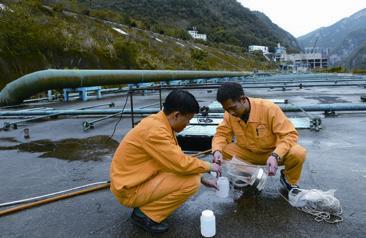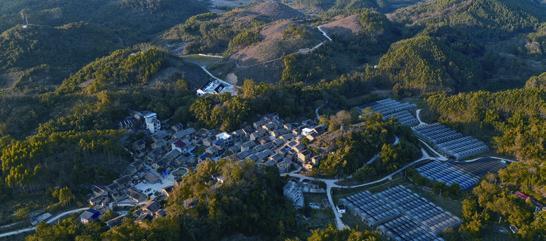POSITIVE OUTLOOK
2019-12-27ByLiXiaoyang
By Li Xiaoyang



As the countdown to 2020 starts, the key tasks for the new year were mapped out and the state of the economy assessed at the annual Central Economic Work Conference held in Beijing from December 10 to 12.
Despite mounting internal and external risks in 2019, the economy has maintained sound growth with notable progress in the battles against major financial risks, poverty and pollution, a statement released after the conference said.
“China has the confidence as well as conditions to achieve its annual growth goals,”Meng Wei, a spokesperson for the National Development and Reform Commission, told a recent news conference.
Key targets
In 2020, stable growth and high-quality development will remain the key objectives. There is a focus on innovation-driven, coordinated, green, open and shared development to complete building a moderately prosperous society across the board and achieve the goals of the 13th Five-Year Plan (2016-20).
Industrial and consumption upgrading remains a commitment. In addition, a proactive fiscal policy and prudent monetary policy will be launched to improve peoples wellbeing and boost input in infrastructure. Poverty alleviation will get greater importance.
ChiNext, a board of the Shenzhen Stock Exchange aimed at encouraging innovation, and the National Equities Exchange and Quotations for trading in shares of companies not listed on the Shanghai or Shenzhen stock exchanges, also known as the New Third Board, will be reformed for the first time to improve support to small and medium-sized enterprises and better support the real economy.
Since insufficient demand was a challenge to economic growth in 2019, the measures are expected to drive up domestic demand in the new year, Zhang Liqun, a researcher with the Development Research Center of the State Council, Chinas cabinet, told Beijing Review.
As the conference prioritized poverty elimination in 2020, improving peoples livelihood becomes a significant task. The statement said the government will continue to support the most impoverished regions and focus on areas of wide concern such as employment, pension and housing.
The job market has registered stable growth in 2019. Data from the National Bureau of Statistics (NBS) shows nearly 13 million new urban jobs were created in the first 11 months, exceeding the annual target of 11 million new jobs. In 2020, a stable workforce will be ensured and the quality of employment improved.
As the population begins to gray, the pressure on pension funds has grown. NBS data shows at the end of 2018, there were 249 million people aged 60 or older. To provide more cushions for them, it will be ensured that pension benefits reach them in time and in full. Construction of a unified national pension fund system will be accelerated.
Some regions are struggling with pension deficits as the aging population has seen the number of pension fund contributors dip. To address the urgency, Guan Bo, a researcher with the Academy of Macroeconomic Research(AMR), said a temporary mechanism has been adopted since 2018 to channel money from provinces with a larger pension fund balance to places in need. “In the new year, more efforts are needed to put the national system in place to relieve payment pressure by utilizing idle funds,” he said.
The policies on the property market will remain consistent. The conference reaffirmed that houses are meant to be lived in and not for speculation, and encouraged both housing purchases and rentals.
Jiang Guojun, an analyst with Zhuge.com, a real estate website, interprets it to mean that the rein on the property market will continue. However, in some cities policies may be changed in line with local conditions to better ensure peoples wellbeing, Jiang told China.org.cn.
Boosting key drivers
The conference agreed that consumption and investment will be boosted as the key driving forces of domestic economic growth. This will be done mainly by unleashing the potential of the considerable market and encouraging investment in areas related to peoples livelihood, high-end manufacturing industries and infrastructure.
In 2019, consumption has seen robust growth. In the first 11 months, the retail sales of consumer goods rose 8 percent year on year. On November 11, the annual online shopping bonanza saw sensational growth with the major e-commerce giants all registering record sales.

NBS spokesperson Fu Linghui told a press conference on December 16 that stable employment and improving social security systems will continue to drive domestic consumption. But while encouraging consumption, the government needs to focus on boosting investment to expand domestic demand, Zhang added. This can enhance the performance of enterprises and ensure a stable job market.
Improving inputs in new industries related to peoples wellbeing such as elderly care and health can help meet upgrading domestic demand, Xu Hongcai, deputy chief economist with the China Center for International Economic Exchanges, said.
“Industrial upgrading can create new demands,” he told Beijing Review, suggesting that a virtuous circle can be developed.
The conference has encouraged increasing research and development inputs in advanced manufacturing industries. As China pursues high-quality development, hi-tech manufacturing and modern services have gained rising support. The NBS said investment in hi-tech manufacturing and services rose 14.8 percent and 13.1 percent respectively in the JanuaryNovember period. According to Xu, advanced technologies such as information technology and 3D printing can help upgrade traditional manufacturing industries and improve supporting industries, thereby boosting the whole industrial chain. “China needs to invest more in such high-end sectors to sharpen the edge of domestic manufacturing industries,” he said.
According to Zhang, a proactive fiscal policy and prudent monetary policy are needed to give full play to the role of investment. The statement stressed that more efforts will be made to improve the effects of the fiscal policy and allow the monetary policy moderate flexibility.
The policy of reducing taxes and cutting fees, a boon to individuals and enterprises, is on the 2020 agenda too. According to the Ministry of Finance, individual income tax collections fell by 26.8 percent year on year from January to November. The year-on-year growth of revenue from domestic value-added tax stood at 2.3 percent, dropping 7.1 percentage points from the same period in 2018.
“The policy will be further promoted to reduce the burden on domestic enterprises and improve peoples living standards,” Yang Zhiyong, a researcher with the Chinese Academy of Social Sciences, told Xinhua News Agency.
The prudent monetary policy will also be continued into the new year to keep the growth of credit and social financing in line with economic development, increase medium- and long-term financing of the manufacturing industry, and make financing more accessible to and affordable for the private sector and small businesses, the statement said.

“Besides new technologies, innovation in management and systems is also needed, which calls for a more favorable environment through further opening up,” Ma Xiaohe, another researcher with the AMR, said.
Future outlook
Looking into 2020, China is expected to complete the scheduled tasks and embark on the 14th Five-Year Plan (2021-25). Some of the tough battles it has been fighting have not yet come to an end. Although absolute poverty can be eliminated across the board in 2020, comparative poverty needs to be addressed as the urban-rural disparities and income gaps remain, Liu Yongfu, head of the State Council Leading Group Office of Poverty Alleviation and Development, told a press conference in 2019.
“Self-reliance of the poor groups needs to be improved for sustainable prosperity,” Zhang Qi, President of the China Institute for Poverty Reduction, Beijing Normal University, said.
While poverty reduction calls for strong economic growth, Zhang Liqun pointed out that environmental protection requires equal importance. Curbing financial risks is also a protracted battle, despite the success in recent years. Xiao Yuanqi, chief risk officer and spokesperson of the China Banking and Insurance Regulatory Commission, told a news conference on October 21 that the banking sector had disposed of 4.9 trillion yuan ($700 billion) of bad loans since the beginning of 2017 till that date.
According to Zhang Liqun, China needs to ensure a sound economic performance to boost the real economy and cope with financial risks in 2020.
He remains upbeat about the performance in the new year. “Although more external challenges and downward pressure are likely, the sound economic fundamentals and steady restructuring can ensure stable growth,” he said.
